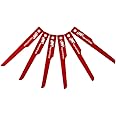When it comes to power tools, the air reciprocating saw stands out as an essential tool for both professionals and DIY enthusiasts. Known for its versatility and efficiency, this tool can tackle a variety of tasks, from cutting metal to handling wood and plastic. However, not all air reciprocating saws are created equal. In this article, we will explore the top five features you should consider when selecting an air reciprocating saw to ensure you make an informed purchase.
1. Power and Speed

The power of an air reciprocating saw is primarily determined by its air consumption and motor speed. The higher the air pressure (measured in PSI), the more powerful the tool will be. Additionally, the stroke rate, which often ranges from 2,500 to 3,000 strokes per minute (SPM), plays a crucial role in the saw’s cutting efficiency.
- Air Pressure: Look for saws that operate effectively at 90 PSI for optimal performance.
- Stroke Rate: A higher stroke rate means faster cutting, which is beneficial for large projects.
For example, a reciprocating saw with a stroke rate of 3,000 SPM can cut through metal pipes much faster than a model with only 2,500 SPM. This increased speed can significantly reduce project time, making it an essential feature for those who rely on efficiency.
2. Ergonomic Design and Weight

An air reciprocating saw can be a physically demanding tool to use, especially during extended periods. Therefore, an ergonomic design is crucial for comfort and reducing fatigue. The weight of the tool also contributes to its usability.
- Weight: Lighter models (under 5 lbs) are easier to handle and reduce operator fatigue.
- Grip: Look for saws with rubberized grips that provide better control and comfort during use.
For instance, the Ingersoll Rand 429 has a lightweight design and an ergonomic grip, making it a preferred choice for many professionals who require extended use without compromising comfort.
3. Blade Compatibility and Changing Mechanism

The versatility of your air reciprocating saw will depend significantly on its blade compatibility and the ease with which you can change blades. Different materials require different blades, and the ability to switch them out quickly can enhance your productivity.
- Blade Types: Ensure the saw accommodates various blade types (wood, metal, plastic).
- Tool-Free Blade Change: Look for models with a tool-free mechanism, allowing for quick and easy blade changes.
For example, the Chicago Pneumatic CP7900 features a tool-free blade change system that lets users switch blades in seconds, making it ideal for projects that require frequent material changes.
4. Noise Level and Vibration Control

Noise and vibration are significant factors to consider when choosing an air reciprocating saw. Excessive noise can lead to hearing damage over time, while high vibration levels can cause fatigue and reduce precision during cuts.
- Noise Reduction Features: Look for saws that have built-in noise dampening systems.
- Vibration Control: Tools with anti-vibration technology help reduce the impact of vibrations on the user.
According to a study by the National Institute for Occupational Safety and Health (NIOSH), prolonged exposure to high noise levels can lead to irreversible hearing loss. Therefore, investing in a quieter model not only protects your hearing but can also enhance your overall cutting experience.
5. Durability and Build Quality

Lastly, the durability of an air reciprocating saw is vital, especially for those who use it in demanding environments. A robust build quality ensures that the tool can withstand the rigors of daily use without succumbing to wear and tear.
- Materials: Look for saws made from high-quality materials like aluminum or steel.
- Warranty: A longer warranty often indicates a manufacturer’s confidence in their product’s durability.
For instance, the Milwaukee 6515 features a rugged design and is built to withstand heavy use, making it a favorite among construction professionals. Its five-year warranty further underscores its durability and reliability.
Conclusion: Making an Informed Choice

Choosing the right air reciprocating saw is critical for both efficiency and safety. By focusing on these top five features—power and speed, ergonomic design and weight, blade compatibility and changing mechanism, noise level and vibration control, and durability and build quality—you can make a well-informed decision that meets your needs. Whether you’re a professional contractor or a weekend warrior, investing in a high-quality air reciprocating saw can significantly enhance your productivity and comfort during use.
In summary, always prioritize tools that combine power with ergonomic design, ensure quick blade changes, minimize noise and vibrations, and offer robust durability. With these considerations in mind, you’ll be well-equipped to select the best air reciprocating saw for your projects.





